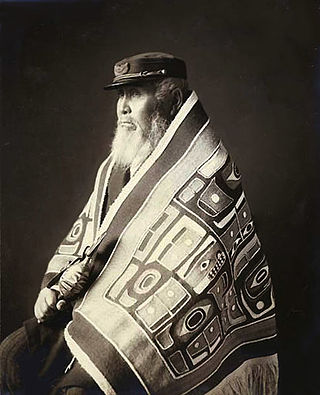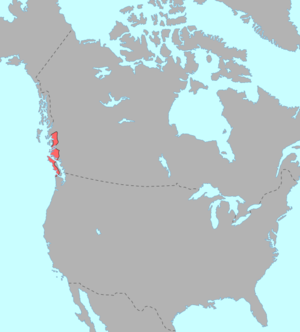
The Nuu-chah-nulth, also formerly referred to as the Nootka, Nutka, Aht, Nuuchahnulth or Tahkaht, are one of the Indigenous peoples of the Pacific Northwest Coast in Canada. The term Nuu-chah-nulth is used to describe fifteen related tribes whose traditional home is on the west coast of Vancouver Island.

The Makah are an Indigenous people of the Pacific Northwest Coast living in Washington, in the northwestern part of the continental United States. They are enrolled in the federally recognized Makah Indian Tribe of the Makah Indian Reservation, commonly known as the Makah Tribe.
Ditidaht or diitiidʔaaʔtx̣ is a South Wakashan (Nootkan) language spoken on the southern part of Vancouver Island. Nitinaht is related to the other South Wakashan languages, Makah and the neighboring Nuu-chah-nulth.
The Haisla language, X̄a'islak̓ala or X̌àh̓isl̩ak̓ala, is a First Nations language spoken by the Haisla people of the North Coast region of the Canadian province of British Columbia, who are based in the village of Kitamaat. This is 10 km from the town of Kitimat at the head of the Douglas Channel, a 120 km fjord that serves as a waterway for the Haisla and for the aluminum smelter and accompanying port of the town of Kitimat.

The Heiltsuk or Haíɫzaqv, sometimes historically referred to as Bella Bella, are an Indigenous people of the Central Coast region in British Columbia, centred on the island community of Bella Bella. The government of the Heiltsuk people is the Heiltsuk Nation, though the term is also used to describe the community. Its largest community is Bella Bella.
Heiltsuk, Haíłzaqvḷa, also known as Bella Bella and Haihais, is a dialect of the North Wakashan (Kwakiutlan) language Heiltsuk-Oowekyala that is spoken by the Haihai (Xai'xais) and Bella Bella First Nations peoples of the Central Coast region of the Canadian province of British Columbia, around the communities of Bella Bella and Klemtu, British Columbia. Bella Bella is the headquarters of the Heiltsuk Nation government.
Nuu-chah-nulth, a.k.a.Nootka, is a Wakashan language in the Pacific Northwest of North America on the west coast of Vancouver Island, from Barkley Sound to Quatsino Sound in British Columbia by the Nuu-chah-nulth peoples. Nuu-chah-nulth is a Southern Wakashan language related to Nitinaht and Makah.
The Mowachaht/Muchalaht First Nations are a First Nations government on the west coast of Vancouver Island in the Canadian province of British Columbia. The Mowachaht/Muchalaht First Nations are a member nation of the Nuu-chah-nulth Tribal Council, which spans all Nuu-chah-nulth-aht peoples except for the Pacheedaht First Nation.

Tseshaht First Nation is an amalgamation of many tribes up and down Alberni Inlet and in the Alberni Valley of central Vancouver Island in the Canadian province of British Columbia. They are a member of the Nuu-chah-nulth Tribal Council which includes all other Nuu-chah-nulth-aht peoples except the Pacheedaht First Nation.
The Nuu-chah-nulth Tribal Council is a First Nations Tribal Council in the Canadian province of British Columbia, located on the west coast of Vancouver Island. The organization is based in Port Alberni, British Columbia.

The Pacheedaht First Nation is a First Nations band government based on the west coast of Vancouver Island in British Columbia, Canada. Although the Pacheedaht people are Nuu-chah-nulth-aht by culture and language, they are not a member of the Nuu-chah-nulth Tribal Council and define themselves differently.
The WuikinuxvIPA:[ʔuwik'inuxʷ],, also rendered Oweekano (Pre-1976); Oowekeeno (1976-2003) are an Indigenous First Nations people of the Central Coast region of the Canadian province of British Columbia, located around Rivers Inlet and Owikeno Lake, to the north of Queen Charlotte Strait. The Wuikinuxv people and their neighbours the Heiltsuk and Haisla peoples were in the past sometimes known incorrectly as the "Northern Kwakiutl".
Heiltsuk–Oowekyala is a Northern Wakashan (Kwakiutlan) language spoken in the Central Coast region of the Canadian province of British Columbia, spoken by the Wuikinuxv (Oweekeno) and Heiltsuk peoples. It has two dialects, Heiltsuk and Oowekyala (Wuikyala), which unlike other Wakashan languages are tonal. It has no traditional name, so the hyphenated construction Heiltsuk–Oowekyala is used by linguists. Ethnologue calls this language "Heiltsuk", with the Bella Bella dialect (Heiltsuk) labelled "Northern Heiltsuk" and the Oowekyala dialect labeled "Southern Heiltsuk".
The Makah language is the indigenous language spoken by the Makah. Makah has not been spoken as a first language since 2002, when its last fluent native speaker died. However, it survives as a second language, and the Makah tribe is attempting to revive the language, including through preschool classes. The endonym for the Makah is qʷi·qʷi·diččaq.

The Indigenous peoples of the Pacific Northwest Coast are composed of many nations and tribal affiliations, each with distinctive cultural and political identities. They share certain beliefs, traditions and practices, such as the centrality of salmon as a resource and spiritual symbol, and many cultivation and subsistence practices. The term Northwest Coast or North West Coast is used in anthropology to refer to the groups of Indigenous people residing along the coast of what is now called British Columbia, Washington State, parts of Alaska, Oregon, and Northern California. The term Pacific Northwest is largely used in the American context.
The Lake Cowichan First Nation, government and reserve is located in Lake Cowichan, British Columbia.
Uu-a-thluk is the aquatic management organization of the Nuu-chah-nulth people on Vancouver Island, British Columbia.
The Nuu-chah-nulth people are a group of First Nations peoples living on the west coast of Vancouver Island, British Columbia, Canada.

Whaling on the Pacific Northwest Coast encompasses both aboriginal and commercial whaling from Washington State through British Columbia to Alaska. The indigenous peoples of the Pacific Northwest Coast have whaling traditions dating back millennia, and the hunting of cetaceans continues by Alaska Natives and to a lesser extent by the Makah people.








